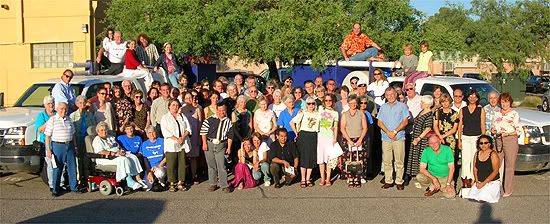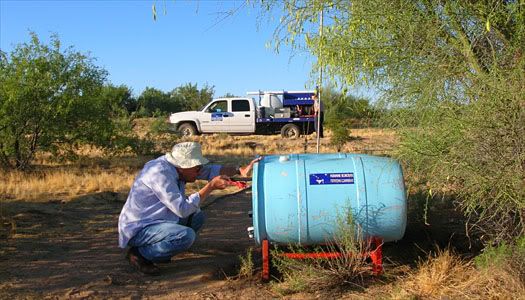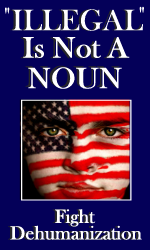Meet the "most dangerous" people on our southern border
This past Wednesday the headlines could not have made it any clearer.
"Maps Show Illegal Migrants Best Routes" LA Times
"Mexican Commission to Give Migrants Maps" ABC
"Mexico to Give Migrants Maps of Arizona" AOL News
"Mexico gives migrants road map to U.S." CNN
"Mexican Government to Hand Out Arizona Maps to Migrants" FOX
"U.S. opposes Mexico giving maps to migrants: Chertoff" USA TODAY
On a whole most of the stories varied little, hitting on a common theme:
MEXICO CITY, Mexico (AP) -- A Mexican government commission said Tuesday it will distribute at least 70,000 maps showing highways, rescue beacons and water tanks in the Arizona desert to curb the death toll among illegal border crossers.
The National Human Rights Commission, a government-funded agency with independent powers, denied the maps - similar to a comic-style guide booklet Mexico distributed last year - would encourage illegal immigration.
Officials said the maps would help guide those in trouble find rescue beacons and areas with cell phone reception. The maps will also show the distance a person can walk in the desert in a single day.
-snip-
The comic booklet for migrants was distributed by the government in early 2005 and warned of the perils of crossing illegally into the United States, while offering tips to stay safe.
The booklet, of which about 1.5 million were printed, enraged some advocates of stricter immigration policies in the United States, who argue that it encouraged illegal migration.
CNN
So there it was, plain in black and white … The Mexican government was once again encouraging their people to cross the border illegally … not only encouraging them, but giving them maps to make the trip easier. Acting like the AAA or Mapquest for "illegal aliens." Case closed … or was it?
more below the fold
Tag: immigration
Some of the longer stories did bury this towards the bottom of their coverage:
They were designed by the Tucson, Ariz.-based rights group Humane Borders, which operates some of the desert water stations. The group previously distributed about 100 posters in the Mexican border town of Sasabe.
Rev. Robin Hoover, president of Humane Borders, said maps are needed in southern Mexico so migrants can weigh the risks before leaving home.
A quick check of Humane Borders website reveals they did far more than "design" the maps. For the past five years they have been leading advocates for ending migrant death in the desert. The faith-based group, co-founded by Rev. Robin Hoover, pastor of Tucson's First Christian Church, not only maintains more than 70 emergency water stations on and near the U.S.-Mexican border, they publish posters that warn migrants about the dangers they face trying to cross into the United States, and produced the maps that not only highlight the location of Humane Borders and Water Station Inc. water stations, U.S. Border Patrol emergency beacons, and the extent of cell phone coverage in the region, but also the locations where over 1000 migrants have perished in southern California and Arizona from Oct. 1, 1999, to Aug. 11, 2005 .

Humane Borders was conceived as an open and transparent organization that emphasizes collaboration as a means to ending migrant death in the desert. By collaborating with private and government stakeholders, we are allowed access to land to maintain water stations, while guaranteeing we will not damage property or natural resources, and that we will not break the law by transporting illegal immigrants.
The press release from Humane Borders explains how the Mexican government became involved in the distribution of the maps.
Humane Borders, Inc. and Mexico's National Commission for Human Rights announce a joint migrant safety education project. A press conference hosted by a delegation of 21 Humane Borders volunteers will be held in Mexico City January 24 at 10a.m. The media are invited to Hotel Maria Cristina, Rio Lerma 31, Col. Cuauhtemoc. The hotel is just three blocks east of the US Embassy on Paseo de la Reforma.
Using Global Information System technology, Humane Borders produces accurate migrant death maps and migrant warning posters in an attempt to educate migrants as to the specific dangers of crossing the border in the desert. However, it has been difficult to systematically distribute these maps in critical areas in the interior of Mexico. Mexico's human rights commission (CNDH) has agreed to both print and widely distribute these maps into sending communities in as effort to alter the annual migration patterns and migrant decision-making.
The organization makes no bones about its opposition to current US immigration policies for humanitarian reasons.
Humane Borders, motivated by faith, offers humanitarian assistance to those in need through more than 70 emergency water stations on and near the border
Deployment of water saves lives and invites public discourse: We want to legalize the undocumented migrants now working and living in the United States; create a responsible guest worker program; increase the number of visas for Mexican nationals; demilitarize border; support economic development in Mexico; provide more federal aid for local medical service providers, law enforcement and adjudication, land owners and managers.
One look at the information contained in the warning posters they publish reveals they are far from encouraging migrants to make the dangerous trip through the desert southwest:
Migrant Warning Posters: Don't Do It! It's Hard! There's Not Enough Water!
These posters are distributed widely in churches, shelters, shops and other locations on the south side of the U.S.-Mexican border. They warn migrants in stark terms about the dangers they face trying to cross into the United States illegally, on foot through the desert, despite what human smugglers tell them. The estimated walking times from entry points are highlighted, as are the sites of migrant deaths and the location of water stations.
The news coverage of this event says volumes about the current state of discourse about immigration and immigration reform. Why is it that all major news agencies chose to play up the Mexican government's involvement in the story, while playing down that of Humane Borders? I believe the answer is quite simple.
One factor is of course the hysteria that can be drummed up over the Mexican angle, it an easily sensationalized aspect of the story and makes for the type of tabloid style headline that major news organizations favor these days, but on closer examination the situation reveals far more.
These kind of stories, when presented in the one-sided and biased way in which this one was, play into the underlying xenophobia that has lately become the norm in discussions of immigration and immigration reform.
Most of all I believe that the misrepresentation of this story shows just how hypocritical we have become as a nation on the issue of faith, and faith based charity or humanitarian aid.
If these same people were bringing water to a devastated New Orleans, or sending care packages to the troops in Iraq, the would be lauded as true good Samaritans, yet when they work tirelessly to save the lives of those near deaths door in the desert Southwest, the media essentially ignores them. Why?
They were played down because they are not helping the "right people", because they are helping migrants. Most of all they were ignored because their actions highlight the hypocrisy of much of what passes for religiosity or faith these days. They back up their beliefs with action, and that is rare in todays world.
"They will neither hunger nor thirst, nor will the desert heat or the sun beat upon them. He who has compassion on them will guide them and lead them beside springs of water."
-- Isaiah 49:10
Many leaders of todays Religious Right talk endlessly of the good works they've done, how they have fed the starving in Africa, or how they have brought their "faith" to millions throughout the world. They brag of the legislation they have lobbied for and the men they have helped put into political office. Yet when a mother and child are dying of thirst only miles from Tucson or Phoenix, they believe that people of faith should turn a blind eye. The people of Humane Borders see no reason that they should, and thank God for that.


































No comments:
Post a Comment